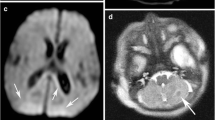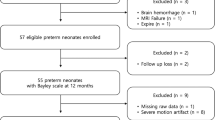Abstract
On the basis of MRI examination in 88 neonates and infants with perinatal asphyxia, we defined 6 different patterns on T2-weighted images: pattern A-scattered hyperintensity of both hemispheres of the telencephalon with blurred border zones between cortex and white matter, indicating diffuse brain injury; pattern B-parasagittal hyperintensity extending into the corona radiata, corresponding to the watershed zones; pattern C-hyper-and hypointense lesions in thalamus and basal ganglia, which relate to haemorrhagic necrosis or iron deposition in these areas; pattern D-periventricular hyperintensity, mainly along the lateral ventricles, i.e. periventricular leukomalacia (PVL), originating from the matrix zone; pattern E-small multifocal lesions varying from hyper-to hypointense, interpreted as necrosis and haemorrhage; pattern F-periventricular centrifugal hypointense stripes in the centrum semiovale and deep white matter of the frontal and occipital lobes. Contrast was effectively inverted on T1-weighted images. Patterns A, B and C were found in 17%, 25% and 37% of patients, and patterns D, E and F in 19%, 17% and 35%, respectively. In 49 patients a combination of patterns was observed, but 30% of the initial images were normal. At follow-up, persistent abnormalities were seen in all children with patterns A and D, but in only 52% of those with pattern C. Myelination was retarded most often in patient with diffuse brain injury and PVL (patterns A and D).
Similar content being viewed by others
References
Robertson C, Finner N (1985) Term infants with hypoxicischemic encephalopathy: outcome at 3.5 years. Dev Med Child Neurol 27:473–484
Volpe JJ (ed) Neurology of the newborn. Saunders, Philadelphia, pp 258–262
Levene M (ed) (1987) Neonatal neurology. Churchill Livingstone, Edinburgh, pp 157–200
Nelson KB, Leviton A (1991) How much of neonatal encephalopathy is due to birth asphyxia? Am J Dis Child 145:1325–1331
McArdle CB, Richardson CJ, Hyden CK, Nicholas DA, Amparo EG (1987) Abnormalites of the neonatal brain: MR imaging. II. Hypoxic-ischemic brain injury. Radiology 163:395–403
Barkovich AJ, Truwit CL (1990) Brain damage from perinatal asphyxia: correlation of MR findings with gestational age. AJNR 11:1087–1096
Byrne P, Welch R, Johnson MA, Darrah J, Piper M (1990) Serial magnetic resonance imaging in neonatal hypoxic ischemic encephalopathy. J Pediatr 117:694–700
Truwit CL, Barkovich AJ, Koch TK, Ferriero DM (1992) Cerebral palsy: MR findings in 40 patients. AJNR 13:67–78
Johnson MA, Pennock JM, Bydder GM, Dubowitz LMS, Thomas DJ, Young IR (1987) Serial MR imaging in neonatal cerebral injury. AJNR 8:83–92
Keeney SE, Adcock EW, McArdle CB (1991) Prospective observations of 100 high-risk neonates by high-field (1.5 Tesla) magnetic resonance imaging of the central nervous system. I. Intraventricular and extracerebral lesions. Pediatrics 87:421–430
Keeney SE, Adcock EW, McArdle CB (1991) Prospective observations of 100 high-risk neonates by high-field (1.5 tesla) magnetic resonance imaging of the central nervous system. II. Lesions associated with hypoxic-ischemic encephalopathy. Pediatrics 87:431–438
Steinlin M, Dirr R, Martin E, Boesch C, Largo RH, Fanconi S, Boltshauser E (1991) MRI following severe perinatal asphyxia: preliminary experience. Pediatr Neurol 7:164–170
Larroche JC (1977) Developmental pathology in neonates. Excerpta Medica, Amsterdam
Leech R, Alvord EC (1977) Anoxic-ischemic encephalopathy in the human neonatal period. The significance of brainstem involvment. Arch Neurol 34:109–113
Flodmark O, Fitz CR, Harwood-Nash DC (1980) Computed tomographic diagnosis and short-term prognosis of intracranial hemorrhage and hypoxic-ischemic brain damage in neonates. J Comput Assist Tomogr 4:775–787
Lipp-Zwahlen AE, Deonna T, Micheli JL, Calame A, Chrzanowski R, Cetre E (1985) Prognostic value of neonatal CT scans in asphyxiated term babies: low density score compared with neonatal neurological signs. Neuropediatrics 16:209–217
Dubowitz LMS, Bydder GM, Mushin J (1985) Developmental sequence of periventricular leukomalacia. Correlation of ultrasound, clinical and magnetic resonance functions. Arch Dis Child 60:349–355
Deleted
Martin E, Boesch C, Zuerrer M, Kikinis R, Molinari L, Kaelin P, Boltshauser E, Duc G (1990) MR imaging of brain maturation in normal and developmentally handicapped children. J Comp Assist Tomogr 14:685–692
Stricker T, Martin E, Boesch C (1990) Development of the human cerebellum observed with high-field-strength MR imaging. Radiology 177:431–435
Martin E, Krassnitzer S, Kaelin P, Boesch C (1991) MR imaging of the brainstem: normal postnatal development. Neuroradiology 33:391–395
Konishi Y, Kuriyama M, Hayakawa K, Konishi K, Yasujima M, Fujii Y, Sudo M (1990) Periventricular hyperintensity detected by magnetic resonance imaging in infancy. Pediatr Neurol 16:229–232
Rosales RK, Riggs HE (1962) Symmetrical thalamic degeneration in infants. J Neuropathol Exp Neurol 21:372–376
Norman MG (1972) Antenatal neuronal loss and gliosis of the reticular formation, thalamus, and hypothalamus. Neurology 22: 910–916
Myers RE (1975) Four patterns of perinatal brain damage and their conditions of occurence in primates. In: Meldrum BS, Marsden CD (eds) Advances in neurology. Raven Press, New York, pp 223–234
DiMario FJ, Clancy R (1989) Symmetrical thalamic degeneration with calcification of infancy. Am J Dis Child
Voit T, Lemburg P, Neuen E, Lumenta C, Stork W (1987) Damage of thalamus and basal ganglia in asphyxiated full-term neonates. Neuropediatrics 18:176–181
Eicke M, Briner J, Willi U, Uehlinger J, Boltshauser E (1992) Symmetrical thalamic lesion in infants. Arch Dis Child 67:15–19
Dietrich RB, Bradley WG (1988) Iron accumulation in the basal ganglia following severe ischemic anoxic insults in children. Radiology 168:203–206
Wilson DA, Steiner RE (1986) Periventricular leukomalacia: evaluation with MR imaging. Radiology 160:507–511
Flodmark O, Lupton B, Li D (1989) MR imaging of periventricular leukomalacia in childhood. AJR 152:583–590
Zimmermann RD, Flemming CA, Lee BCP, Saint-Louis LA, Deck MD (1986) Periventricular hyperintensity as seen by magnetic resonance: prevalence and significance. AJNR 7:13–20
Author information
Authors and Affiliations
Rights and permissions
About this article
Cite this article
Baenziger, O., Martin, E., Steinlin, M. et al. Early pattern recognition in severe perinatal asphyxia: a prospective MRI study. Neuroradiology 35, 437–442 (1993). https://doi.org/10.1007/BF00602824
Received:
Revised:
Issue Date:
DOI: https://doi.org/10.1007/BF00602824




